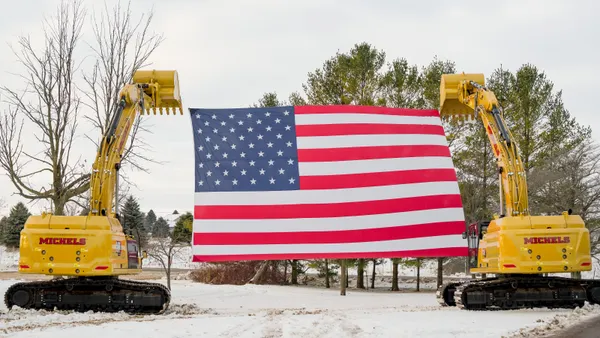Labor and materials are arguably the two most critical ingredients of any construction project. No buildings transform skylines, no bridges span rivers and no homes rise from foundations without them. That's why pricing of these two production components can mean cost-cutting is in store for other areas of the job budget or, given steep-enough increases, the scuttling of the project altogether.
The most recent numbers from the Bureau of Labor Statistics revealed a 4.8% rise in material prices between February 2016 and February 2017. Ken Simonson, chief economist for the Associated General Contractors of America, said this "sharp U-turn" came after declines of 3.5% in 2015 and 2.7% in 2016.
Those declining prices are quickly becoming a distant memory for some segments of the materials sector. Most of the overall uptick in prices can be attributed to an increase in demand driven by ramped-up building activity, but the industry can also look to the factors of energy prices, a more stable global market and tariffs, which Simonson said were tacked onto certain types of foreign steel after protests by U.S. steel manufacturers.
One of the most common concerns industry experts cited for this year has been the rising cost of doing business due to material cost increases. So how has the turnaround in material prices affected construction so far, and what can the construction industry expect in the coming months and years?
A look at lumber
Simonson said that one area homebuilders are watching particularly closely is the price of wood products. "I have heard homebuilders are concerned about what’s happening with lumber," he said. "Because of no agreement with Canada, there is a threat of much higher tariffs."
About a month ago, the National Association of Home Builders reported that softwood lumber prices were beginning to rise as a result of the dispute between the U.S. and Canada and that the Random Lengths Framing Lumber Composite Index was at $391 on Feb. 10, up from $366 on Feb. 3, which was the biggest single-week increase since August 2003.
A one-year extension to the Canadian-U.S. agreement expired in October, and, since then, the homebuilding industry has urged U.S. manufacturers to boost production and have even made trips to other countries — such as Chile — to explore importing lumber. To add to the uncertainty, some U.S. manufacturers claim that Canada is undercutting their prices, while, at the same time, the U.S. government is trying to decrease Canada’s market share from 28% to 22%.
The rising cost of doing business
For some contractors, talk of material prices thus far is just that — talk. However, the talk could be more damaging than the actual threat.
"Perception is not necessarily reality," said Jesse Fowler, president of Tellus Design + Build in Southern California. A dialogue about the possibility of rising material prices can become a self-fulfilling prophecy, he said.
Fowler noted that there is always uncertainty about how much prices will go up, which sales representatives sometimes use as leverage to persuade companies to place orders and take advantage of lower prices while they can.
For Connecticut construction material supplier A.H. Harris & Sons, the battle is rebar (steel reinforcing bar) and wire mesh. In the last 120 days, prices have gone up $140 per ton, about 30% year over year, an increase the like of which the company hasn’t seen since 2008, according to president and CEO Kimberly Corwin.
There has been little pushback from customers around overall price increases, Corwin said, but some competitors are absorbing the increases and not charging customers for them, leading Harris’ customers to question their pricing in that area.
"Price increases are a natural part of doing business and, in most cases, help us to provide for our associates with pay raises and offset the costs of rising insurance costs," she said. "The frustration comes when manufacturers make exceptions or competitors don’t pass along the increases, which upsets the natural balance in the marketplace."
The Trump 'trigger'
In a January letter to customers, Corwin chalked up the increases to rising scrap steel costs and price hikes from their manufacturers, but Corwin said there’s another reason as well. "The presidential election was the trigger," she said. "President Trump’s promise to 'make America great again' by limiting imports has empowered the steel mills to issue price increases."
Corwin said that if prices for rebar — which is an integral part of most construction projects — continue to rise, it could result in stalled projects as developers wait for the prices to come down.
Rebar is certainly going to be a huge part of President Donald Trump’s planned U.S.–Mexico border wall, as are concrete and cement products, although the impact can’t be truly measured until officials decide on a final design.
Concrete is largely a local material, so wall construction could affect that segment's pricing in nearby markets like San Diego, El Paso, TX, San Antonio, TX, and Brownsville, TX, but not nationally, according to Simonson. A big enough wall, he said, could impact prices nationally for the other material components.
Fowler said a massive wall project would be enough to impact pricing of both labor and material all the way up to Orange County, CA. "It’s all really the same market," he said. "I could see it definitely having an effect."
As for the rest of the year, Simonson doesn’t see drastic increases but instead said 2017 will likely end up with a total increase between 2% and 4%.
Corwin added that construction companies should "be alert."
"As the economy continues to improve, that will drive demand. Demand drives increase," she said.



















